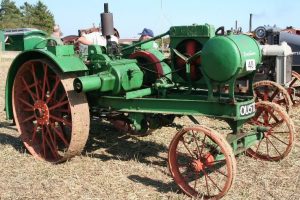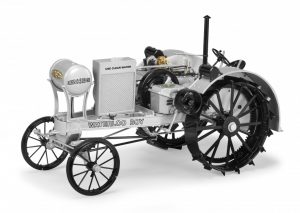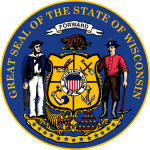dakotas
 What would the modern farm be without the tractor? People in the 19th century knew exactly what it would be, even if they had no idea what a tractor was. John Froelich was born on November 24, 1849, in Iowa. His life would end up changing much in the agricultural industry. As an adult, Froelich operated a grain elevator and mobile threshing service. His job was to bring a crew to local farms every year at harvest time. He hired a crew and dragged a heavy steam-powered thresher through Iowa and the Dakotas, threshing farmers’ crops for a fee. I suppose it was a good way to make a living, but his machine was bulky, hard to transport, and expensive to use. To top it off, it was also dangerous…one spark from the boiler on a windy day, and he could find the whole prairie ablaze.
What would the modern farm be without the tractor? People in the 19th century knew exactly what it would be, even if they had no idea what a tractor was. John Froelich was born on November 24, 1849, in Iowa. His life would end up changing much in the agricultural industry. As an adult, Froelich operated a grain elevator and mobile threshing service. His job was to bring a crew to local farms every year at harvest time. He hired a crew and dragged a heavy steam-powered thresher through Iowa and the Dakotas, threshing farmers’ crops for a fee. I suppose it was a good way to make a living, but his machine was bulky, hard to transport, and expensive to use. To top it off, it was also dangerous…one spark from the boiler on a windy day, and he could find the whole prairie ablaze.
Froelich knew that this was no way to do business. He decided that he had to try something new. In 1890, instead of that cumbersome, hazardous steam engine, Froelich came up with the idea of a gas powered engine. The size comparison alone made it a far superior choice. So, he and his blacksmith mounted a one-cylinder gasoline engine on his steam engine’s running gear and set off for a nearby field to see if it worked. To their excitement, it did. The tractor  Traveled at a speed of three miles per hour. Of course, that was going to take them a long time to go from one location to another. The real test came when they took their new machine on the road for the annual threshing season. The good news is that the machine was a success there too. The crew threshed more than a thousand bushes of grain every day, 72,000 bushels in all, and they used only 26 gallons of gasoline. Of even greater importance, was that they did the whole thing without one fire.
Traveled at a speed of three miles per hour. Of course, that was going to take them a long time to go from one location to another. The real test came when they took their new machine on the road for the annual threshing season. The good news is that the machine was a success there too. The crew threshed more than a thousand bushes of grain every day, 72,000 bushels in all, and they used only 26 gallons of gasoline. Of even greater importance, was that they did the whole thing without one fire.
It was time to take the project to the next level. Froelich found eight investors, and they formed the Waterloo Gasoline Traction Engine Company. They built four prototype tractors and sold two. Unfortunately, both were soon returned. Rather than lose the company, and to make money, the company branched out into stationary engines. That was somewhat more successful and its first engine powered a printing press at the Waterloo Courier newspaper. Froelich was happy  with the success, but that was really not where his interests were. He was into farming equipment and wanted to make an engine that worked for that. So he left the company in 1895. Froelich might have jumped the gun a little bit, because Waterloo kept working on its tractor designs. The designs still weren’t wildly successful, and between 1896 and 1914, Waterloo sold just 20 tractors in all. Success finally came when in 1914, the company introduced its first Waterloo Boy Model “R” single-speed tractor, which sold very well…118 in 1914 alone. The next year, its two-speed Model “N” was even more successful. In 1918, the John Deere plow-manufacturing company bought Waterloo for $2,350,000.
with the success, but that was really not where his interests were. He was into farming equipment and wanted to make an engine that worked for that. So he left the company in 1895. Froelich might have jumped the gun a little bit, because Waterloo kept working on its tractor designs. The designs still weren’t wildly successful, and between 1896 and 1914, Waterloo sold just 20 tractors in all. Success finally came when in 1914, the company introduced its first Waterloo Boy Model “R” single-speed tractor, which sold very well…118 in 1914 alone. The next year, its two-speed Model “N” was even more successful. In 1918, the John Deere plow-manufacturing company bought Waterloo for $2,350,000.
 My life began in Superior, Wisconsin. Superior is a small town located at the tip of Lake Superior, which is the largest of the Great Lakes. I have always felt close ties to Superior and to Wisconsin, in general, because while I have not lived there since I was three years old, it was the place of my birth, and the place where my Uncle Bill Spencer and his family lived for many years, as well as many of my great grandparents’ family.
My life began in Superior, Wisconsin. Superior is a small town located at the tip of Lake Superior, which is the largest of the Great Lakes. I have always felt close ties to Superior and to Wisconsin, in general, because while I have not lived there since I was three years old, it was the place of my birth, and the place where my Uncle Bill Spencer and his family lived for many years, as well as many of my great grandparents’ family.
In the early years of the area, the Native American Indian Tribes called it home. The first Europeans to live there were the British and French, and the American settlers who lived in Wisconsin when it was a territory. One tribe, the Meskwaki Indians were particularly hostile toward the French, but many of the Indians got along well with the pioneers. The Great Lakes area increased dramatically after the decline of the British influence following the War of 1812. This was a land with a mix of pioneers and Indians. Of course, like most areas, the Indians were eventually placed on reservations.
Like every state in the United States, Wisconsin started as a US Territory, and when there were enough people to make statehood a necessity, each one became a state. Wisconsin initially became a terriroty on this day, April 20, 1836. Initially, it included all of the present-day states of Wisconsin, Minnesota, Iowa, and part of the Dakotas east of the  Missouri River. Much of that territory was part of the Northwest Territory, which was ceded by Britain in 1783. The portion which is now the Dakotas was originally part of the Louisiana Purchase. Eventually, the states would separate their areas, leaving Wisconsin with the area it now occupies.
Missouri River. Much of that territory was part of the Northwest Territory, which was ceded by Britain in 1783. The portion which is now the Dakotas was originally part of the Louisiana Purchase. Eventually, the states would separate their areas, leaving Wisconsin with the area it now occupies.
My people would arrive in the area much later, but many of them would stay in the area of Wisconsin and Minnesota for generations, and even to this day. For me, there will always be a place in my heart for Wisconsin, especially Superior, and the Great Lakes, especially Lake Superior. It is a beautiful area that my family has called home for generations, and I will always love it.

